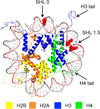Probing Enhanced Double-Strand Break Formation at Abasic Sites within Clustered Lesions in Nucleosome Core Particles
- PMID: 28005342
- PMCID: PMC5372979
- DOI: 10.1021/acs.biochem.6b01144
Probing Enhanced Double-Strand Break Formation at Abasic Sites within Clustered Lesions in Nucleosome Core Particles
Abstract
DNA is rapidly cleaved under mild alkaline conditions at apyrimidinic/apurinic sites, but the half-life is several weeks in phosphate buffer (pH 7.5). However, abasic sites are ∼100-fold more reactive within nucleosome core particles (NCPs). Histone proteins catalyze the strand scission, and at superhelical location 1.5, the histone H4 tail is largely responsible for the accelerated cleavage. The rate constant for strand scission at an abasic site is enhanced further in a nucleosome core particle when it is part of a bistranded lesion containing a proximal strand break. Cleavage of this form results in a highly deleterious double-strand break. This acceleration is dependent upon the position of the abasic lesion in the NCP and its structure. The enhancement in cleavage rate at an apurinic/apyrimidinic site rapidly drops off as the distance between the strand break and abasic site increases and is negligible once the two forms of damage are separated by 7 bp. However, the enhancement of the rate of double-strand break formation increases when the size of the gap is increased from one to two nucleotides. In contrast, the cleavage rate enhancement at 2-deoxyribonolactone within bistranded lesions is more modest, and it is similar in free DNA and nucleosome core particles. We postulate that the enhanced rate of double-strand break formation at bistranded lesions containing apurinic/apyrimidinic sites within nucleosome core particles is a general phenomenon and is due to increased DNA flexibility.
Figures







Similar articles
-
Enhanced Cleavage at Abasic Sites within Clustered Lesions in Nucleosome Core Particles.Chembiochem. 2018 Oct 4;19(19):2061-2065. doi: 10.1002/cbic.201800338. Epub 2018 Aug 24. Chembiochem. 2018. PMID: 30043401 Free PMC article.
-
Rapid DNA-protein cross-linking and strand scission by an abasic site in a nucleosome core particle.Proc Natl Acad Sci U S A. 2010 Dec 28;107(52):22475-80. doi: 10.1073/pnas.1012860108. Epub 2010 Dec 13. Proc Natl Acad Sci U S A. 2010. PMID: 21149689 Free PMC article.
-
Mechanistic studies on histone catalyzed cleavage of apyrimidinic/apurinic sites in nucleosome core particles.J Am Chem Soc. 2012 Oct 10;134(40):16734-41. doi: 10.1021/ja306858m. Epub 2012 Sep 28. J Am Chem Soc. 2012. PMID: 23020793 Free PMC article.
-
Yeast HMO1: Linker Histone Reinvented.Microbiol Mol Biol Rev. 2016 Nov 30;81(1):e00037-16. doi: 10.1128/MMBR.00037-16. Print 2017 Mar. Microbiol Mol Biol Rev. 2016. PMID: 27903656 Free PMC article. Review.
-
Nucleosome remodelers in double-strand break repair.Curr Opin Genet Dev. 2013 Apr;23(2):174-84. doi: 10.1016/j.gde.2012.12.008. Epub 2013 Jan 23. Curr Opin Genet Dev. 2013. PMID: 23352131 Review.
Cited by
-
Mammalian DNA Polymerase Kappa Activity and Specificity.Molecules. 2019 Aug 1;24(15):2805. doi: 10.3390/molecules24152805. Molecules. 2019. PMID: 31374881 Free PMC article. Review.
-
Effect of Nucleosome Assembly on Alkylation by a Dynamic Electrophile.Chem Res Toxicol. 2019 May 20;32(5):917-925. doi: 10.1021/acs.chemrestox.9b00057. Epub 2019 Mar 27. Chem Res Toxicol. 2019. PMID: 30882212 Free PMC article.
-
Participation of Histones in DNA Damage and Repair within Nucleosome Core Particles: Mechanism and Applications.Acc Chem Res. 2022 Apr 5;55(7):1059-1073. doi: 10.1021/acs.accounts.2c00041. Epub 2022 Mar 10. Acc Chem Res. 2022. PMID: 35271268 Free PMC article.
-
Nucleosomal embedding reshapes the dynamics of abasic sites.Sci Rep. 2020 Oct 14;10(1):17314. doi: 10.1038/s41598-020-73997-y. Sci Rep. 2020. PMID: 33057206 Free PMC article.
-
Enhanced Cleavage at Abasic Sites within Clustered Lesions in Nucleosome Core Particles.Chembiochem. 2018 Oct 4;19(19):2061-2065. doi: 10.1002/cbic.201800338. Epub 2018 Aug 24. Chembiochem. 2018. PMID: 30043401 Free PMC article.
References
-
- Chapman JR, Taylor MRG, Boulton SJ. Playing the end game: DNA double-strand break repair pathway choice. Mol. Cell. 2012;47:497–510. - PubMed
-
- Srivastava M, Raghavan SC. DNA double-strand break repair inhibitors as cancer therapeutics. Chem. Biol. 2015;22:17–29. - PubMed
-
- Srivastava M, Nambiar M, Sharma S, Karki SS, Goldsmith G, Hegde M, Kumar S, Pandey M, Singh RK, Ray P, Natarajan R, Kelkar M, De A, Choudhary B, Raghavan SC. An inhibitor of nonhomologous end-joining abrogates double-strand break repair and impedes cancer progression. Cell. 2012;151:1474–1487. - PubMed
MeSH terms
Substances
Grants and funding
LinkOut - more resources
Full Text Sources
Other Literature Sources
Miscellaneous

